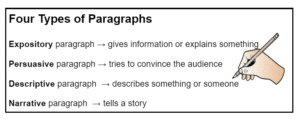Learning how to write a variety of paragraph types is essential for any young writer. As students begin to master the mechanics of writing a sentence, it is time to teach them to create groups of sentences (paragraphs) that work together to develop a topic. The four types of paragraphs that homeschool students should study are expository, persuasive, descriptive, and narrative. These four paragraph types are the building blocks of successful compositions.
Four Types of Paragraphs
Expository Paragraph
An expository paragraph’s primary purpose is to provide information and or explanation of something. The name “expository” suggests that a topic is “exposed” through the writing. In an expository paragraph, the writer would want to be sure to provide details and explanations that allow the reader to better understand the topic.
Like most types of paragraphs, the structure of the expository paragraph consists of three main parts: the opening sentence, body sentences, and a closing sentence.
- The opening sentence introduces the topic.
- The body sentences (also called detail sentences) provide specific details and explanations about the topic.
- The closing sentence brings the topic to a conclusion by restating the topic and giving the reader a sense of having reached a stopping point.
Example of an expository paragraph: In recent years a new food trend has been growing in popularity — eating locally grown and raised food. Concerned citizens trying to reduce their carbon footprints have grown increasingly more aware of how far food must be shipped. Rather than shipping their fruits and vegetables across the country, farmers can sell directly to consumers at local farmers markets or to local grocery stores within a 50 mile radius. By selling their goods to local consumers, farmers can reduce the amount of fossil fuels burned during shipping. Consumers who seek out locally grown food often report that the food is of higher quality than food shipped hundreds or thousands of miles. Without extensive shipping times, local food spends less time in transit and can conceivably make it from the farm to the consumer’s table in a matter of several hours or a few days. With less time to degrade during the shipping process, locally grown foods are often fresher and tastier than foods that spend days or weeks in transit. With these benefits, the trend of eating locally is likely to continue.
Persuasive Paragraph
The purpose of a persuasive paragraph is to convince an audience to agree with the writer’s point of view. In order to be successful, the writer must choose a topic and take a position or state an opinion. The writer must support the position with relevant facts and examples. In order to be effective, the writer should consider the audience when making choices about what kind of evidence to include in the paragraph.
The structure of a persuasive paragraph is similar to other types of paragraphs.
- A persuasive paragraph should begin with an opening sentence that states the topic and the writer’s position while capturing the audience’s attention.
- The body of the paragraph should contain a series of facts and examples that support the writer’s position.
- The closing sentence should restate the writer’s position and usually includes a call to action that directs the reader to a certain course of action.
Example of a persuasive paragraph: People should choose to buy locally grown food whenever it is available. Locally grown food is better for the environment. By reducing shipping distances, fossil fuels can be conserved and carbon emissions can be diminished. In addition, locally grown food is superior in both nutrition and taste. Because locally grown foods can be distributed sooner after harvest, vitamin content and freshness are maximized. Produce that is shipped great distances often spends more time in storage and transit, which causes it to decrease in nutritional value and sometimes to become overripe or spoiled. The right choice is clear — buy locally grown food whenever possible!
Descriptive Paragraph
A descriptive paragraph uses sensory details to describe someone or something. Sensory details are descriptions that appeal to the reader’s physical senses: sight, sound, taste, touch, and smell. A well-written descriptive paragraph allows the reader to form a picture in his or her mind as he or she reads. Writers should include vivid adjectives and action verbs to help the reader with this process.
Descriptive paragraphs are structured like other paragraph types.
- A descriptive paragraph should begin with an opening sentence that includes the topic of the paragraph.
- The body sentences should be filled with sensory details that describe the topic.
- The closing sentence should restate the topic and provide a sense of closure.
Example descriptive paragraph: Farmers markets are a wonderland of bright colors and sweet smells. Wandering from booth to booth, the intoxicating aroma of ruby-red strawberries and fresh-cut cucumbers fills your nose. Rows and rows of farm-made cheeses and artisan breads beckon, begging to go home with you. You gaze at jars of golden honey, pickled cucumbers and okra, and fruit preserves of every kind and color. Friendly farmers tempt you with samples of sun-ripened tomatoes in shades of red, orange, and even purple. As you leave the farmers market with heavy bags and a full heart, you smile and make a promise to yourself to return again the next weekend and the next and the next.
Narrative Paragraph
A narrative paragraph tells about an event. The term personal narrative means that the writer is writing about an event that happened in his or her personal life experience. Narratives should have a clear beginning, middle, and end. Most narratives are told in chronological order and use transitions (like “next” or “then”) to help the audience understand the flow of time. Narratives utilize descriptive writing and contain sensory details (imagery). Narrative writing is the basis of both fiction and non-fiction stories.
The structure of a narrative paragraph may vary depending on the writer’s purpose.
- When following the traditional model, the opening sentence should introduce the subject of the paragraph, which is usually the main action of the story.
- The body should include details about what happened. These details are usually conveyed in chronological order and separated with transition words that help the audience understand the sequence of events.
- The closing sentence should restate the topic or subject and bring the action to a close.
In a work of fiction or when approaching the writing from a non-traditional style, sometimes writers deviate from the traditional paragraph structure as a matter of creative license.
Example of a narrative paragraph: Last Saturday, I visited a local farmers market. I didn’t know what to expect, but having been urged by a friend to try to eat more locally, I decided to give it a try. As I entered the farmers market, my nose was immediately greeted by the inviting scent of fresh strawberries. I meandered from booth to booth admiring the piles of brightly colored fruits and vegetables. As I examined yellow and green varieties of squash, cucumbers of all sizes, and tomatoes of all shapes and colors, I had a hard time deciding what to buy. Sensing my dilemma, a kind farmer offered me a sample of watermelon with a wink and tip of his hat. “Picked fresh today,” he said with a smile. As I bit into the fruit, the sweet juice cooled my parched throat. Later, as I left the market with two bags full of delectable produce, I vowed to eat locally whenever possible.
Learning to write quality paragraphs will help your homeschool student soar to writing success. For quality curriculum, including engaging video instruction, step-by-step modeling of the writing process, graphic organizers, engaging writing prompts, and more, check out Essentials in Writing. Serving students in grades 1- 12, EIW will take the burden off the homeschool parent/teacher and help your homeschool students develop excellent writing skills that will prepare them for college and beyond. Try out our Placement Test today!




